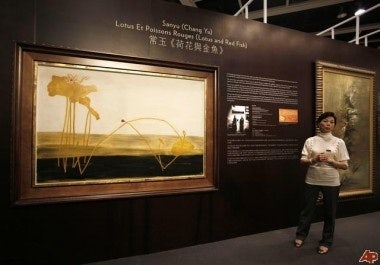"New Chinese Collectors" Gaining Notoriety At Home, As Chinese-Language Outlets Notice Trend Emerging#

The eastward shift we've seen in art collection, reflected by Sotheby's intensified focus on their Hong Kong operations to cater to more Mainland interest, is beginning to make waves in the Chinese media. Art blogs and news sites have noticed the importance of new Chinese collectors, not only in terms of the effect they'll have on the prices of works at auction, but -- perhaps more importantly -- because, after decades of Chinese antiquities and newer, important works of contemporary art leaving China, they're coming back.
Any sort of "homeward shift" is a major story in China, as centuries of works of art being taken away or purchased from "old" collectors or historical sites still sting many art buffs in China and concern prominent members of China's art community. Just last month, the "Godfather" of Chinese contemporary art, Li Xianting, called on Mainland collectors to ratchet up their collecting efforts to ensure younger generations can see Chinese art within China -- rather than having to travel overseas, as do lovers of many important Chinese antiquities.
If recent high-profile auctions, like Sotheby's autumn auction in Hong Kong, are any indication, though New Chinese Collectors certainly don't dominate the auction scene, they're quickly becoming more visible. Whether most of these collectors are motivated more by patriotism, investment potential, a philanthropic desire to provide the works that can educate future generations of Chinese art lovers, or a combination of all three remains to be seen. But if recent Chinese-language articles are any indication, New Collectors, or "New Buyers" as they're often called in the Chinese press, are injecting new life into the Chinese art market.
From Sohu Culture (Chinese) -- Translation by Jing Daily team:
Recently, "New Buyers" have become a hot topic. In the last issue of [China Securities Online], Sotheby's head of Asian contemporary art in Hong Kong, Lin Jiaru, spoke about the emergence of "New Buyers" in the last two seasons' auctions, emphasizing that a large number of these new buyers hailed from Mainland China. In another interview in this issue, Beijing Poly [Auction House] director Zhao Xu also mentioned "New Buyers," revealing that Poly's long-term customers, for "coincidental reasons," gave him inside information about "New Buyers" at Sotheby's in Hong Kong. This seems to confirm the trend pointed out by Lin Jiaru.
Actually, reports in this newspaper about "New Buyers" can be traced back to spring of this year, when Beijing Council International Auction Company general manager Dong Guo-Qiang first discussed these "New Buyers" in an interview with one of our reporters. Only at that time they were predominantly limited to collecting Chinese traditional ink paintings and traditional oil works, because the shape of the Chinese contemporary art market wasn't clear at that time [because of the global economic downturn], so lots of "New Buyers" had adopted a standoffish attitude. Now, after this year's spring auctions and Art Basel, which took place in the first half of the year, up through the Sotheby's autumn auctions [in Hong Kong], "New Buyers" seem to have dropped this "wait-and-see" attitude, and have instead spent generously on contemporary art, signaling a clear reversal in the market.
As Zhao Xu further explained, with the intervention of "New Buyers," the main focus of the contemporary art market will shift to Mainland China.
The noteworthy thing is that the emergence of "New Buyers," on one hand, has raised the popularity of the art market, as it enters a new booming cycle, but it also illustrates that the contemporary art market is still money-driven. As observant people can easily see, although the timing of "New Buyers" in entering the market reflects an adventurous spirit on their part, their choice of investment targets -- as Lin Jiaru pointed out -- remain "blue chips," masterpieces by big names and expensive "classics." While this is a time-tested method for things like traditional ink and oil paintings, it's not really reliable in terms of contemporary art. Since contemporary art hasn't fully gone through the test of time, there are more variables and there is generally more risk than for antiquities.
While new buyers with money to burn can afford to pay high prices, and can also bring "hot money" into the market, in terms of contemporary art it's not just about having enough money. This [idea] has interested a number of curators.
If we can say that the weapon of the "New Buyers" is the capital, then the weapon of the curators is education.
Right now, curators are waving the sword of diligence.
Not long ago, the once-dormant Pace Beijing gallery held a large new Zhang Xiaogang exhibition. At the same time, the Central Academy of Fine Arts Museum put together the "2009 Global Art Collectors Forum" exhibition, "Collusion," and at the moment, Lu Peng -- who is both a curator and art history expert -- is attempting to organize a national art exhibition.
It's natural for people to want to ask, academics can do without the money, but the money needs the support of academics, so is it possible for new buyers and curators to effectively cooperate with one another? Isn't this kind of shared interest a good thing? The problem is that the academic side and the money side compete for the right to speak for the industry, but often bend before interests, tossing away their values and independence. As Lu Peng said, the number of contemporary artists who can anticipate new art trends is miniscule, and in fact, the number of curators who can create academic value and artists who can gain fame and fortune at the same time are also miniscule. However, new buyers are bringing in the money, so curators need to come out some carefully prepared texts following the trajectory of their efforts, and hopefully help find both truth and profits.